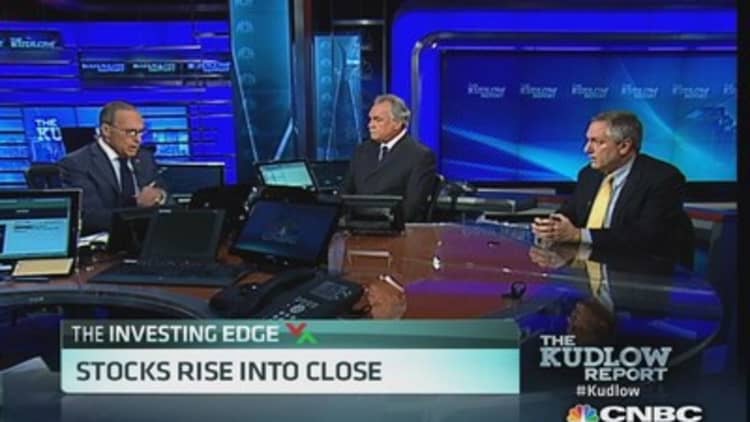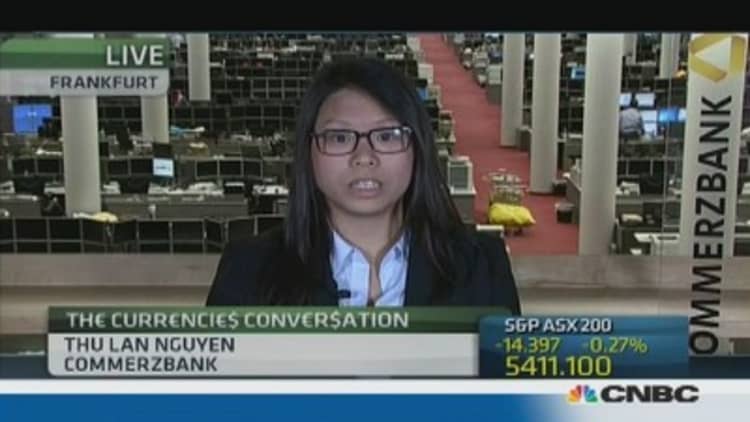The U.S. dollar may continue edging higher this week, defying downbeat economic releases for October tainted by last month's government shutdown, according to CNBC's latest market survey of currency traders, analysts and strategists.
The was holding firm at 80.79 having climbed to a six-week peak on Friday. According to CNBC's latest poll of currency market sentiment, 55 percent (11 out of 20 respondents) believe the U.S. dollar will rise this week. Forty percent (8 out of 20) say the dollar will fall while one respondent expects prices to trade around current levels.
The Labor Department releases its closely-watched non-farm payroll figures for October this Friday. This week's economic indicators also include factory orders on Monday, the ISM services index on Tuesday, third-quarter gross domestic product and weekly jobless claims on Thursday and U.S. personal income and the Thomson Reuters/University of Michigan consumer sentiment index on Friday.
(Read more: Why this one event will dominate trading this week)

"Everyone knows that the October numbers will be distorted by the government shutdown and a snapback is expected in November, so even if payrolls rise less than 100,000, we may not see a massive sell-off in the dollar," said Kathy Lien managing director at BK Asset Management though she warned that "the reliability of the data period should make the Federal Reserve less eager to cut stimulus this year."
The Fed meeting last Thursday signaled stimulus would remain intact though the central bank's outlook was perceived as less dovish than expected, sending the dollar index to a two-week high.
(Read more: Despite bubble signs, bulls to keep edge)
"In failing to live up to dovish market expectations at the last meeting, the [Federal Open Market Committee] reintroduced some risk for near-term tapering," said Todd Elmer, head of G10 foreign-exchange strategy for Asia excluding Japan at Citigroup. "This means that even relatively modest positive surprises from the data might have a stronger impact. I doubt there is much downside for USD on weakness give that the market is still largely positioned 'short' USD."
The dollar on Thursday rose for a fifth straight session against a basket of major world currencies to hit a two-week high, buoyed by the Federal Reserve's latest outlook which was perceived as less dovish than expected.
(Read more: Euro hits 6-week low; Aussie lifted by solid retail sales)
"We will also be hearing from a number of Fed officials" this week, noted BK Asset Management's Lien, "and if they suggest that they prefer earlier rather than later tapering, expect the dollar to rise."
ECB meets
Dollar bulls are also banking on the greenback gaining some further traction against a sliding euro this week after a steep drop in euro area inflation last week, building the case for a rate cut by the European Central Bank, possibly as early as this Thursday's policy meeting.
(Read more: Like the Fed, ECB expected to keep on pumping)

"A potentially dovish ECB would help" further dollar gain against the euro, said Sean Callow, Senior Currency Strategist, Westpac Bank. ECB President Mario Draghi "was relaxed a month ago but 0.7 percent year-on-year inflation cannot be ignored."
Inflation fell to 0.7 percent year-on-year in October - the lowest reading since November 2009 - a flash estimate from the European Union's statistics office showed last Thursday.
"The Eurozone now has lower headline inflation than Japan," said Mansoor Mohi-uddin, chief currency strategist for UBS. October's inflation reading "is far below the European Central Bank's de facto 2 percent target...the recent run up in the euro from 1.28 to 1.38 over the summer has now peaked."
(Read more: Pressure on ECB to cut rates after inflation shock)
The central bank will therefore likely cut its refinance rate from 0.50 percent to 0.25 percent and the marginal lending facility from 1.00 percent to 0.50 percent while keeping the deposit rate unchanged at zero, Mohi-uddin said.
Still, there is a risk that the ECB will refrain from easing until its December meeting when new economic forecasts are published that month, he said. The data will allow ECB officials "to assess whether the decline in services inflation was temporary and whether Italy's VAT tax rise will start to impact inflation," Mohi-uddin explained.
The euro languished at two-week lows early in Asia on Monday, having suffered its biggest drop in over a year last week as expectations grew the ECB will be forced to cut interest rates to shore up growth, Reuters reported.
(Read more: Were the euro bulls just too hasty?)
The Intercontinental Exchange Inc. traded Dollar Index tracks a basket of six major counterparts of the greenback and the euro represents a near 58 percent weighting, making the gauge prone to swings in the single European currency.
"The ECB announcement bears [are] watching closely," said Nick Bennenbroek, Head of currency strategy at Wells Fargo. "With respect to inflation, risks are typically described as balanced. A noteworthy change here would be if the ECB said inflation risks were to the downside, or expressed concerns that the current level of inflation was too low."
— By CNBC's Sri Jegarajah. Follow him on Twitter: @cnbcSri


